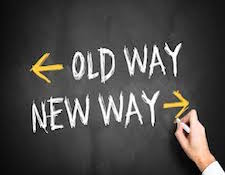It’s the time of year for saving money!
Recently, I saw a commercial claiming the “New JC Penney.” It suddenly struck me that I had not been in a JC Penny’s store, or a Sears for that matter, in years – many years, in fact. I see companies like JC Penney and Sears as victims of their own circumstances and a reluctance to embrace change. So I decided a little experiment was in order. Besides, I needed to go to the mall anyway.
 I rode over the the Penny’s store at the local mall and made my way to the men’s department. I made sure I was causally strolling around and spending enough time looking at pants and shirts to attract the interest of a sales person. Not surprisingly, I found myself alone.
I rode over the the Penny’s store at the local mall and made my way to the men’s department. I made sure I was causally strolling around and spending enough time looking at pants and shirts to attract the interest of a sales person. Not surprisingly, I found myself alone.
Finally, a sales associate approached and asked what is perhaps the most incorrect question anyone in retail sales might ask – “can I help you?” “Of course,” I thought to myself and answered with what is almost a conditional response – “no thank you, I’m just looking.”
My curiosity not yet satisfied, I decided to make my way to a different mall and visit Nordstrom’s. Once again, I was browsing in the men’s department looking at pants and shirts. Nordstrom, by contrast, had several sales people readily available and one approached me in almost no time at all.
This time, the sales person had a little different opening. “I see that you are looking at some of our pants. I just wanted to let you know that we also have some really nice shirts on sale that will make a nice outfit.” “Wow,” I thought to myself, “someone who gets it.”
In many ways, selling high end audio equipment is like visiting a department store. This is particularly true for a brick and mortar store, because both business types essentially wait for customers to come to them. Yes, there are many audio dealers who visit a client’s home. I suspect, those visitations take place after a client has contacted the dealer – whether in person or by phone.
 I see the selling process being divided into one of two differing methods. One, a sales person is at a fixed location or building and waits for potential customers. And two, a sales person who identifies potential customers by any available method and visits the customer at their place of business or residence. I see the general scope of retail sales, and by extension the retail marketing of high performance audio products as being in the first category. What I’ve been doing for more than the last thirty years falls into the second. While neither is more wrong or right than the other, manifestly both embrace the selling process, the methodology for proficiency at either one might be different.
I see the selling process being divided into one of two differing methods. One, a sales person is at a fixed location or building and waits for potential customers. And two, a sales person who identifies potential customers by any available method and visits the customer at their place of business or residence. I see the general scope of retail sales, and by extension the retail marketing of high performance audio products as being in the first category. What I’ve been doing for more than the last thirty years falls into the second. While neither is more wrong or right than the other, manifestly both embrace the selling process, the methodology for proficiency at either one might be different.
Were I to take a poll, I feel confident I would find audiophiles that have had a positive experience when visiting an audio dealer. They would have been impressed with the sales person’s knowledge of the products and the resultant features. They would be appreciative of the fact the the sales person asked a lot of questions and tried to better understand their equipment and needs.
I’m also very confident I would find those that received a less than positive experience at an audio dealership. Like condescending sales people, being ignored and suggesting the components they were considering were probably too expensive. For fun, wear some old, worn out clothes to an audio dealer and spend some time in the most expensive room on display. See how many people rush to your aid to try and sell you that expensive component.
Everything you have, from the socks in your drawer to the home that puts a roof over your head was touched in some way by a sales person. Naturally, this also includes that reference system you are so proud to own. Hopefully, the purchase of that system was a positive experience. What happens, however, if it wasn’t? Are the dealers who enlist a negative experience for the average consumer, especially for customers on a more limited budget, creating the audio version of the experience I had at JC Penny’s?
 Audiophiles have a lot to say, it seems, about the state of the dealer network in the USA. Some feel their time has passed and would be content with a direct model from the manufacturer. Some value what a dealer has to offer – both in terms of advice, help setting up components, and working with a customer to assemble the best possible system within a given availability of fiscal resources.
Audiophiles have a lot to say, it seems, about the state of the dealer network in the USA. Some feel their time has passed and would be content with a direct model from the manufacturer. Some value what a dealer has to offer – both in terms of advice, help setting up components, and working with a customer to assemble the best possible system within a given availability of fiscal resources.
Using the Internet as a source for a buying decision has changed the game in immeasurable ways. I know of a dealer who lost a sale to a local customer to a dealer a thousand miles away. The customer found the other dealer on the Internet. When the customer got the component, he didn’t know how to set it up. So the customer called the manufacturer, who called the local dealer, the same guy who lost the sale in the first place, and asked him to set up the component for the customer since both were local. This local dealer, at a possible risk of loosing the line, told the manufacturer to get the dealer a thousand miles away to come set it up for the customer. “They sold it,” he told the manufacturer, “let them fix the problem.”
What high performance dealers of today need is greater traffic – more customers calling and visiting to inquire about new products, and also a willingness to work with a local supplier for all the common sense reasons that brings. The big question is how to go about enabling that level of customer participation. Maybe the time has come for audio dealers to break with convention and look for ways to reach out to the customer, rather than waiting for the customer to come to them. How to best accomplish that, one might wonder? That, dear reader, is the big question.





